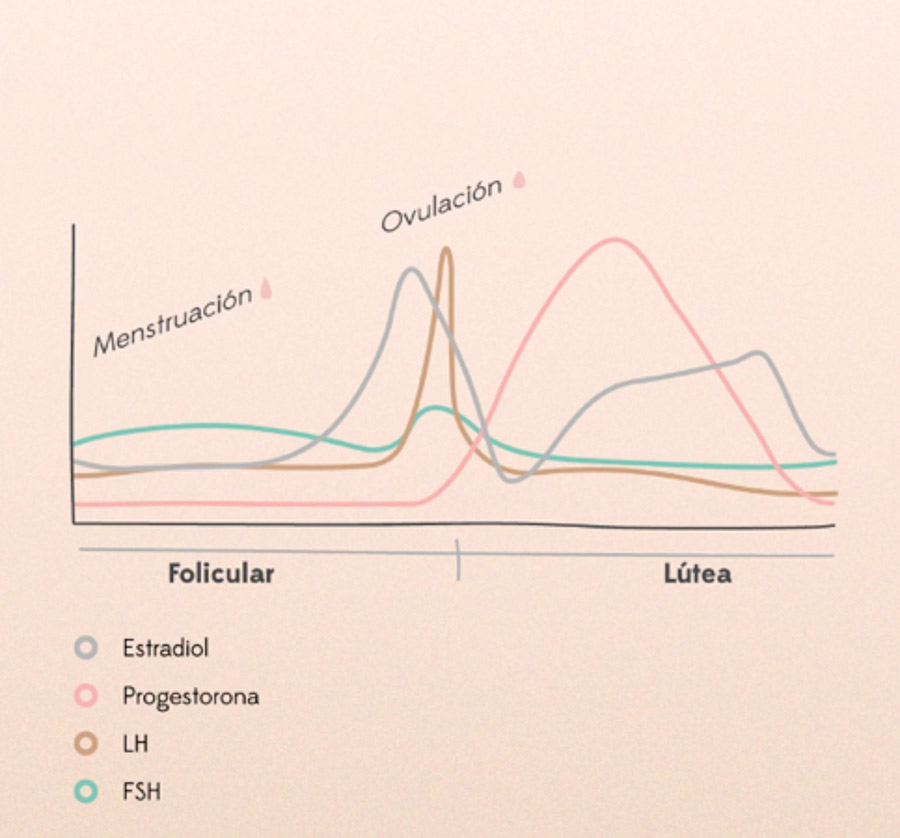Understanding the Menstrual Cycle

As a woman it is very important for you to understand your menstrual cycle, not only to know when your period is due, but to work with your body and not against it. When you know the phases of your menstrual cycle and realise that we are 100% cyclical you begin to optimise your phases and get the most out of them, as well as knowing when you are ovulating and calculating your fertile days.
Specifically, in this article I will talk about three phases of the menstrual cycle: the follicular phase, the ovulatory phase and the luteal phase. But first, do you know what your period is made up of?
Menstrual blood is made up of water, dead endometrial cells, lipids, proteins, hormones such as progesterone and stem cells. The unfertilised egg is nowhere to be found, as it is not fertilised by a sperm, it disintegrates.
Now, let’s go through the phases of the menstrual cycle!
Follicular Phase
The follicular phase begins with the first day of menstruation and ends with ovulation. At the beginning of this phase, the pituitary gland, which is an endocrine gland located at the base of the brain, produces a hormone called follicle stimulating hormone (FSH). This hormone tells the ovaries to prepare for ovulation and thus stimulates the growth of 3 to 30 follicles. Each follicle contains one egg.
As FSH levels decrease, only one of the follicles continues to grow and this will be the dominant follicle responsible for releasing an egg. You should be aware that the rest of the stimulated follicles break down.
The dominant follicle produces oestrogen as it grows, and oestrogen levels peak just before ovulation occurs.
On average, the follicular phase lasts about 13 to 14 days. Of the three phases, this is the one that can vary the most in length, for example, it tends to be shorter near menopause, so it can be both lengthened and shortened.
The increase in oestrogen also begins to prepare the uterus and stimulates the production of luteinising hormone (LH). The phase ends just as the LH level rises sharply.
Characteristics:
- The most “power” phase due to the rise in oestrogen.
- We sleep less and have less appetite.
- Our mood is stable, although we don’t usually feel like making big social plans.
- You feel active, effective, dynamic and competitive, the best at organising.
Ovulatory Phase
As you have seen in the other phase that ends with the LH peak, well, the ovulatory phase begins precisely with this peak of luteinising hormone. This hormone stimulates the dominant follicle, which approaches the surface of the ovary to finally rupture and release the egg.

Just as the follicular phase lasts several days, the ovulatory phase lasts hours! It usually lasts between 16 and 32 hours, although the egg can be fertilised up to a maximum of 12 hours after its release.
Characteristics:
- The “sexiest” phase due to the peak of oestrogen and the rise of progesterone.
- Our libido is high, our skin and hair are in good condition.
- Relationship friendly phase
- You will be empathetic, receptive, negotiating, understanding and more flexible.
- You will be more flirtatious, an ideal time for sexuality.
Luteal Phase
This is one of my favourite phases, it lasts from ovulation until the start of the next period, remember that dominant follicle containing the egg?
Well, once the egg is released, this follicle transforms into what we call the corpus luteum and begins to secrete progesterone, which prepares the uterus in case an embryo implants. Progesterone causes the endometrium to thicken and accumulate fluid and nutrients to nourish a possible embryo. It also thickens the mucus in the cervix and makes it difficult for sperm or bacteria to enter the uterus.
If the egg has not been fertilised, the corpus luteum has an expiry date, i.e. approximately 12 to 14 days post-ovulation, the corpus luteum shuts down and the levels of oestrogen and progesterone decrease, and as a result, the upper layers of the endometrium are shed, causing what is known as menstruation. The luteal phase normally lasts around 14 days, but it is normal for it to last between 9 and 16 days.
And, obviously, a menstrual cycle begins again and so on each month.
Characteristics:
- We start to have much more of an appetite for sweet or savoury foods.
- We will be more vindictive, tough, not very tolerant, very honest = no filters.
- Phase of high intuition and very high emotional sensitivity.
- We may experience lower back pain, headaches, breast pain, swelling, acne, etc…
In future articles I will explain in more detail the emotions, nutrition and sport suitable for each phase.
